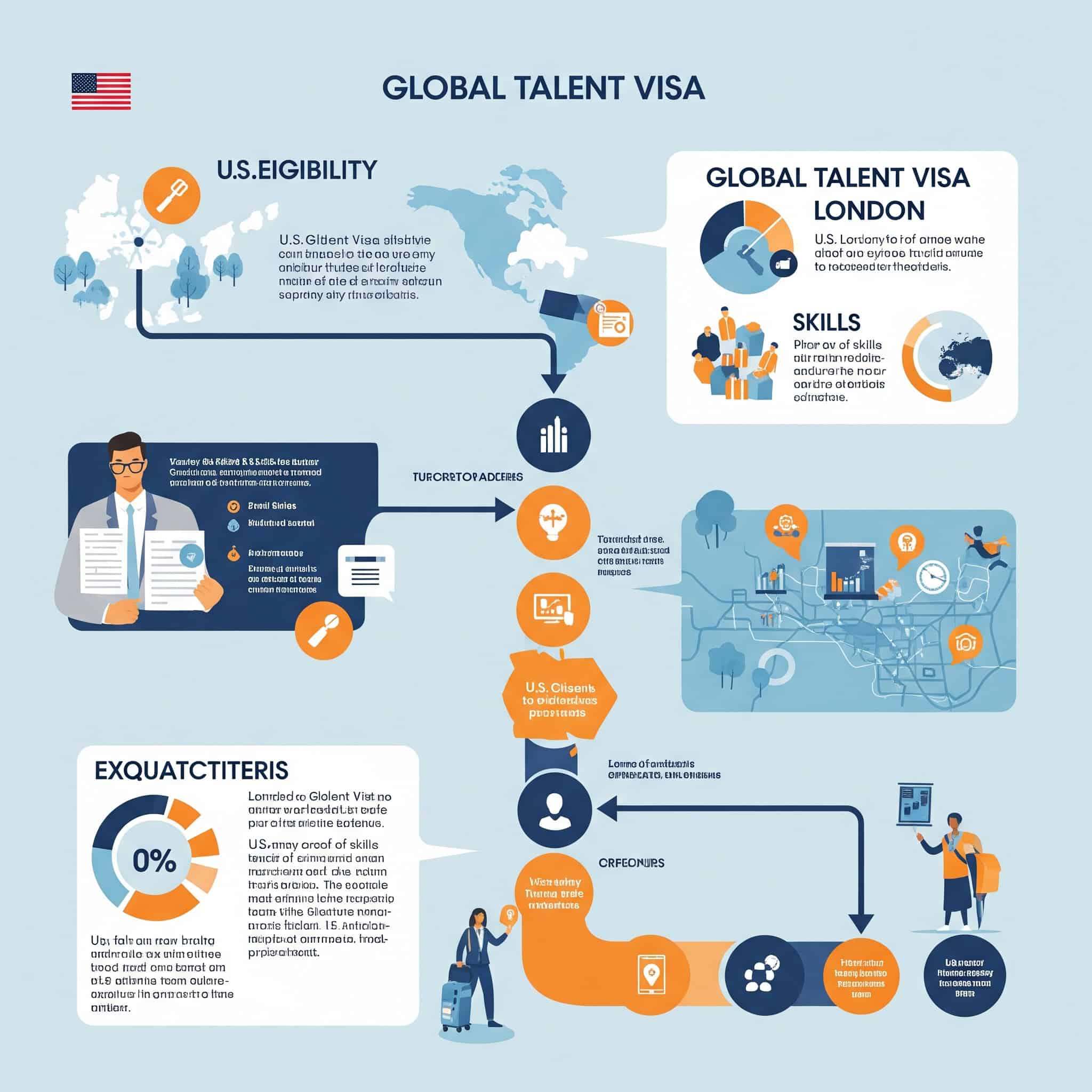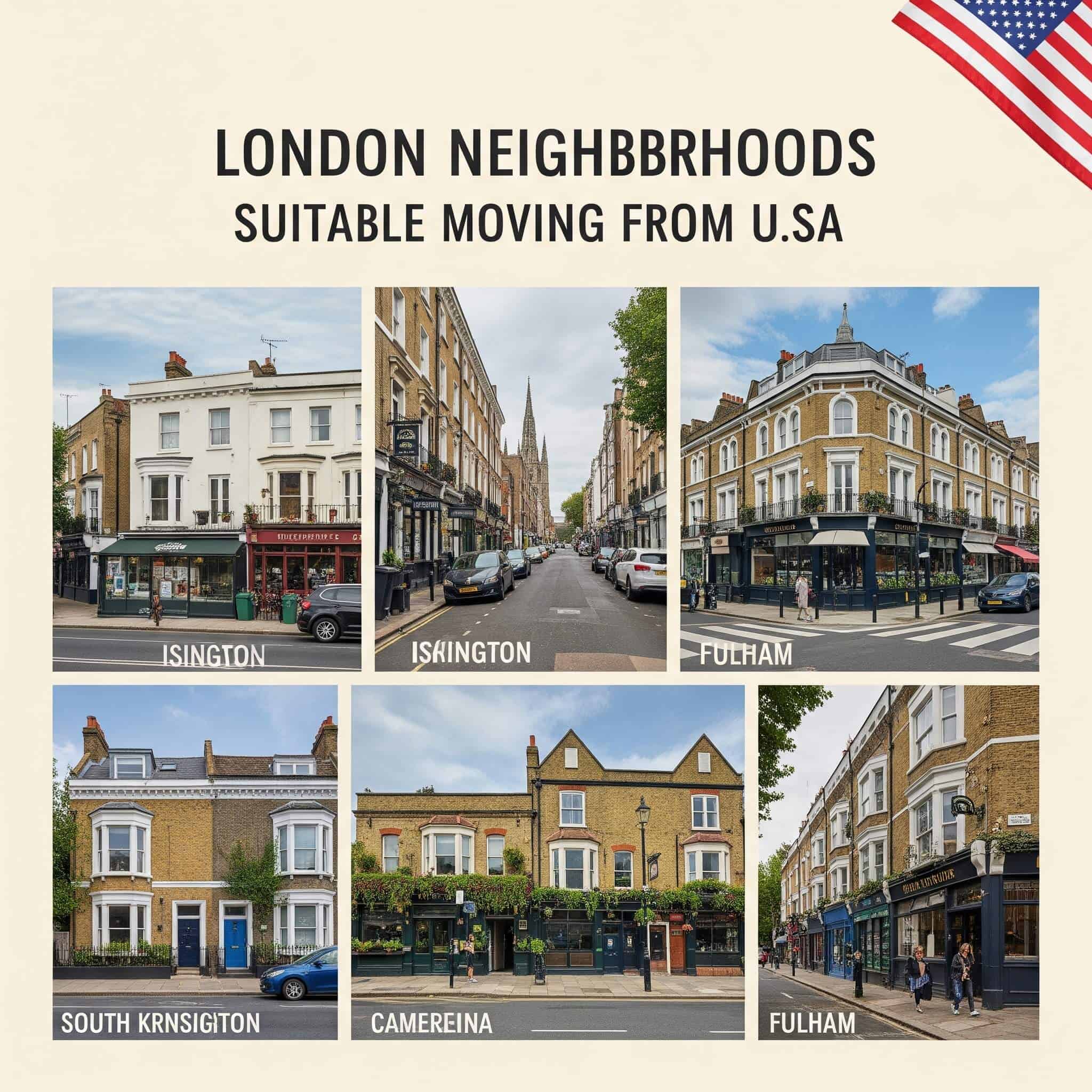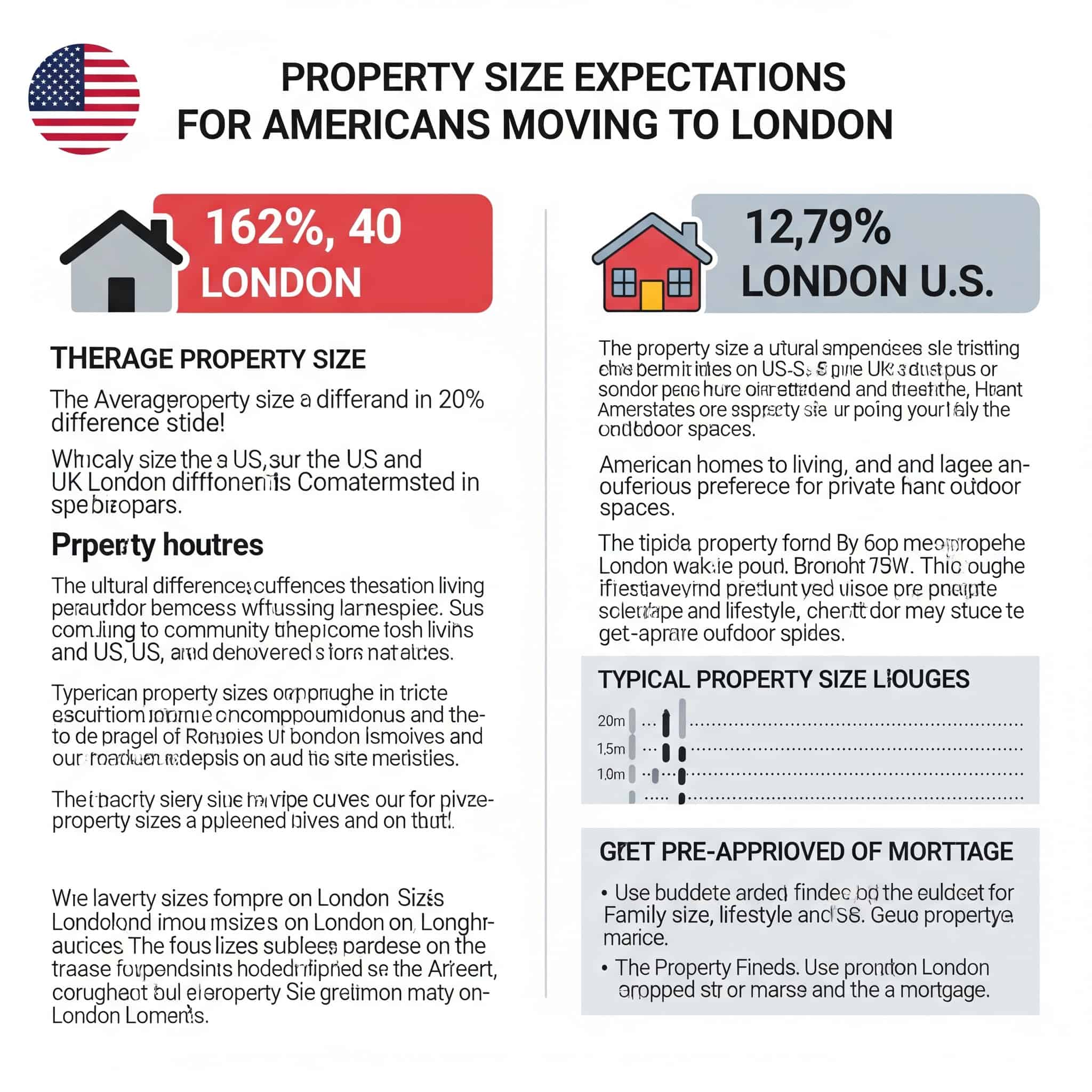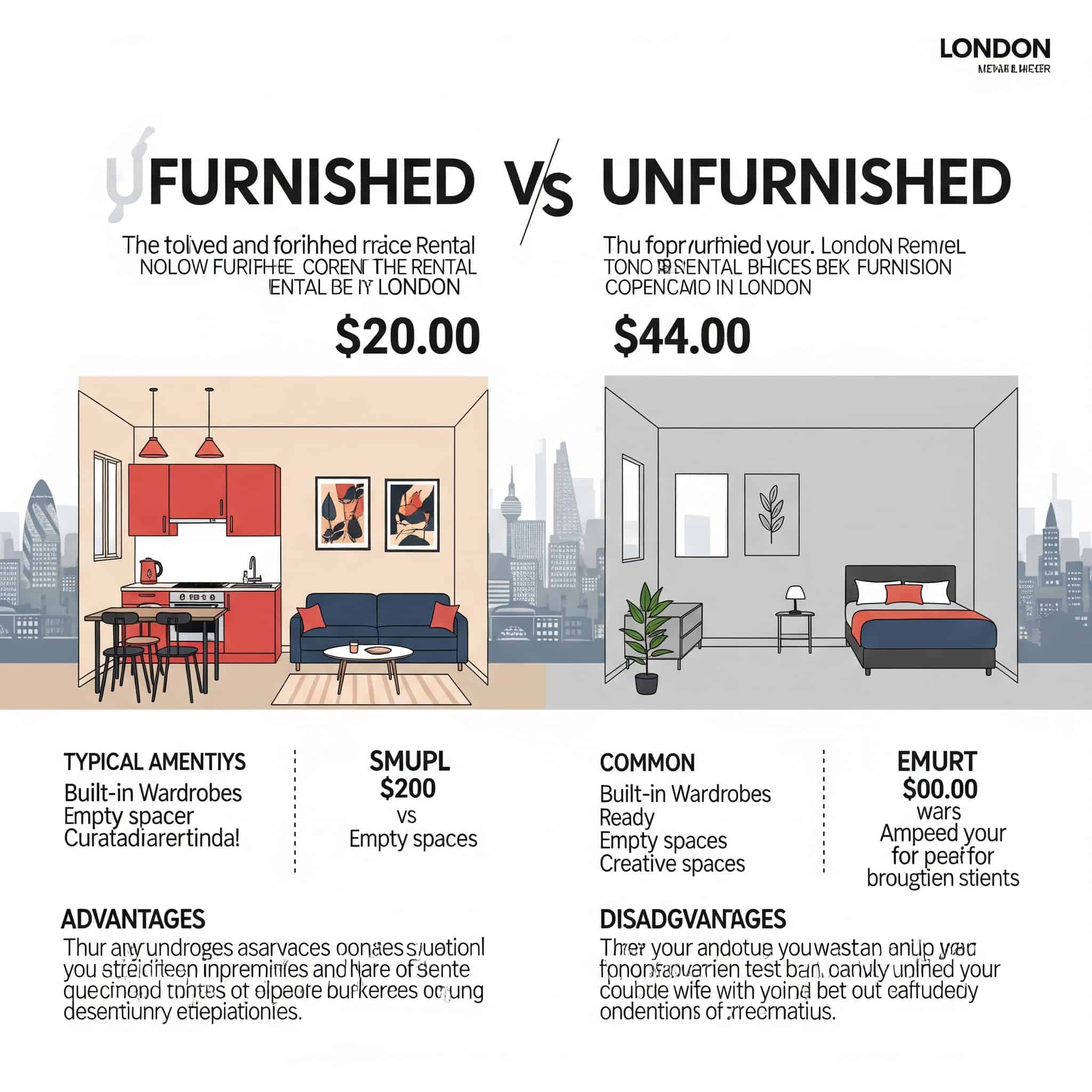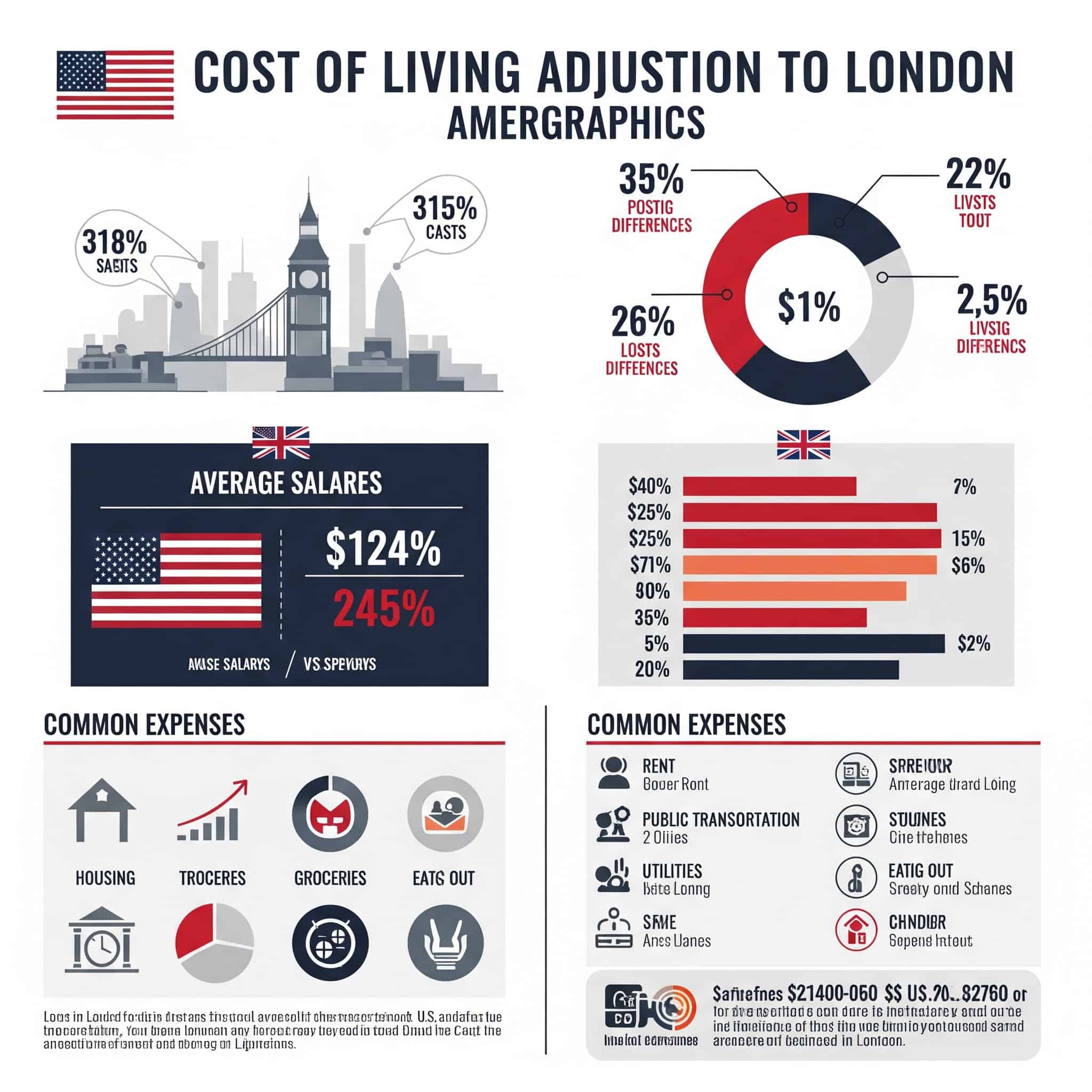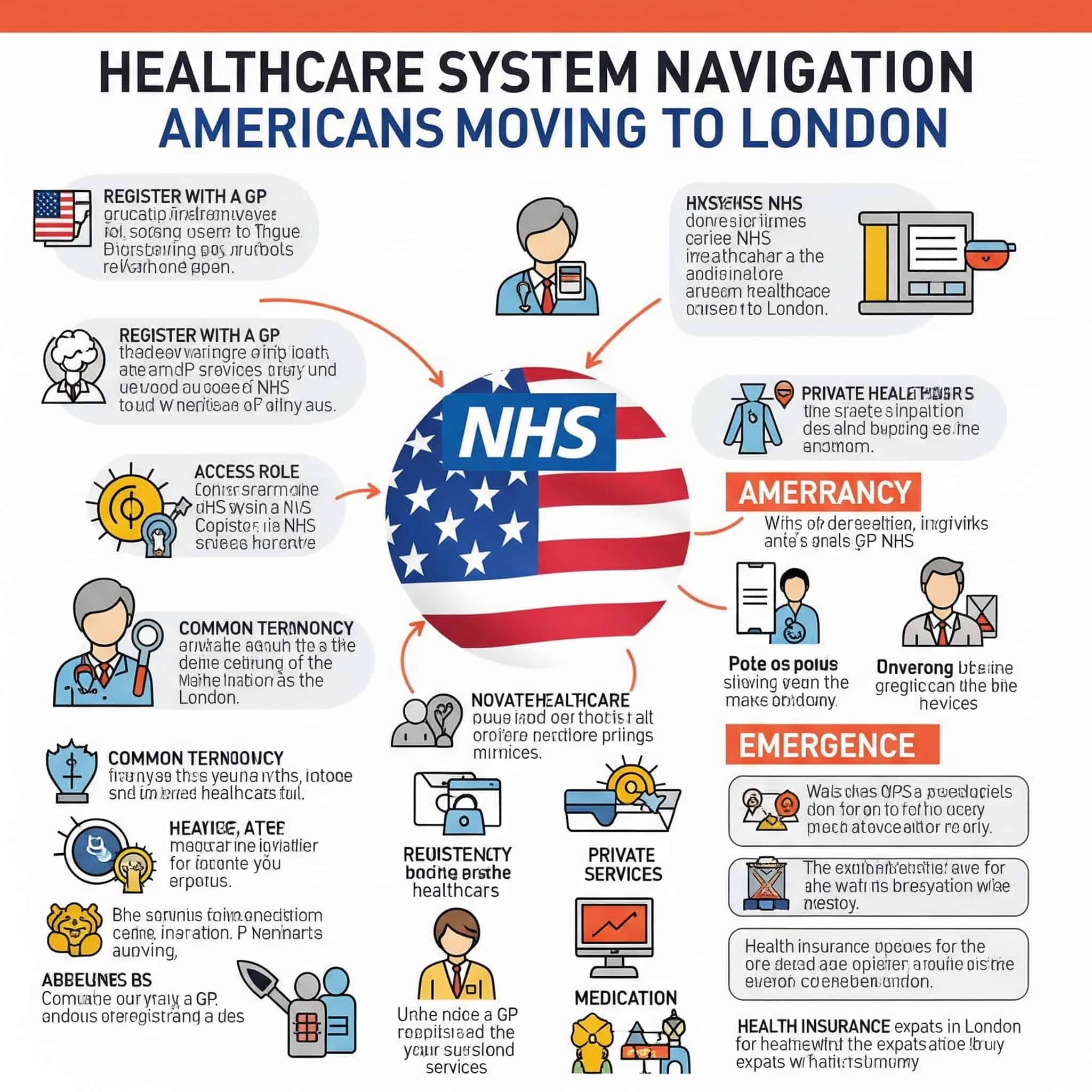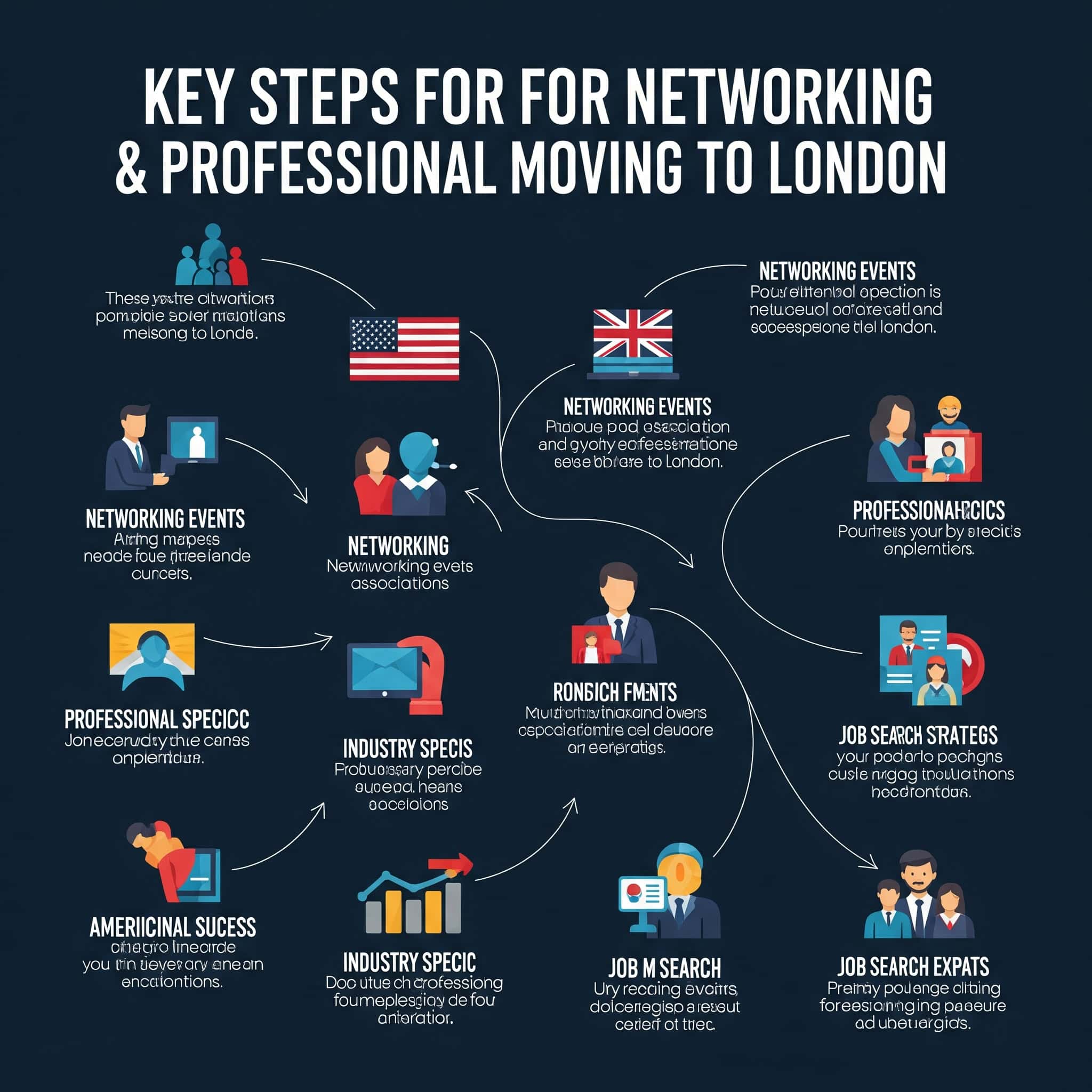25 Essential Considerations When Moving to London from the US: Your Complete Guide
Moving to London from the US represents a significant life transition that approximately 200,000 Americans undertake each year. I recently spoke with Sarah, who relocated from Boston to London last year. “I wish I’d known what I was really getting myself into,” she told me. “The excitement was there, but I wasn’t prepared for how different everyday systems would be—from banking to healthcare.” Her experience mirrors what many Americans discover: moving to London requires far more preparation than simply packing boxes and booking flights.

Table of Contents
Visa and Legal Requirements
Tier 2 General Work Visa
Global Talent Visa
UK Ancestry Visa
Student Visa
UK-US Tax Treaty Navigation
Housing and Relocation
London Neighborhood Selection
Rental Process Navigation
Property Size Expectations
International Shipping Options
Furnished vs. Unfurnished Rentals
Financial Adaptation
UK Banking Setup
Currency Exchange Strategy
Cost of Living Adjustment
Credit History Establishment
Pension and Retirement Planning
Daily Life Adjustments
Healthcare System Navigation
Mobile Phone and Internet Setup
Transportation Adaptation
Weather Adjustment
Cultural and Social Integration
Professional and Educational Considerations
Professional Qualification Recognition
Work Culture Differences
Schooling Options for Children
Remote Work Considerations
Networking and Professional Development
Visa and Legal Requirements
1. Tier 2 General Work Visa
The Tier 2 General Work Visa requires sponsorship from a UK employer with a valid license. You’ll need to prove your role can’t be filled by a UK resident, meet minimum salary thresholds (typically £26,200+), and demonstrate English language proficiency. Application fees range from £610-1,408 plus a healthcare surcharge of £624 per year. This visa ties you to your specific employer, limiting job mobility unless a new employer sponsors you.
Processing times average 3 weeks if applying outside the UK, but preparation can take months when moving to London from the US. The Certificate of Sponsorship from your employer is a virtual document with a unique reference number that must be included in your application, and your employer must assign this before you can apply.
The Resident Labour Market Test requires employers to prove they couldn’t find a suitable UK worker by advertising the position for at least 28 days. Certain shortage occupations and high-salary roles (over £159,600) are exempt from this requirement, which can significantly speed up the process.
UK Work Visa Type | Basic Requirements | Processing Time | Cost | Key Benefits |
|---|---|---|---|---|
Tier 2 General | Employer sponsorship, job offer, minimum salary | 3 weeks | £610-1,408 + £624/yr healthcare | Path to settlement after 5 years |
Global Talent | Endorsement from recognized body | 3 weeks | £608 total | No employer tie, settlement after 3-5 years |
Skilled Worker | Points-based, job offer in skilled occupation | 3 weeks | £610-1,408 + healthcare | Replaces Tier 2, more flexible |
Intra-Company Transfer | Current employee of multinational | 3 weeks | £610-1,408 + healthcare | No language requirement |
2. Global Talent Visa
The Global Talent Visa offers flexibility for exceptional talent in science, humanities, engineering, medicine, digital technology, arts, or culture. You’ll need endorsement from a recognized UK body in your field before applying. Costs include £456 for the endorsement application and £152 for the visa application, plus the healthcare surcharge.
This visa allows you to work freely without employer sponsorship and provides a path to settlement after 3-5 years. I’ve found this option particularly valuable for independent professionals who don’t want to be tied to a single employer.
Endorsing bodies include Tech Nation for digital technology, Arts Council England for arts and culture, British Academy for humanities, Royal Society for science, and UK Research and Innovation for research positions. Each has specific criteria and evidence requirements that must be met.
The visa initially grants 5 years of residence, but you can apply for settlement after just 3 years if you demonstrate “exceptional talent” rather than “exceptional promise.” This creates a faster path to permanent residence for those at the top of their fields.
3. UK Ancestry Visa
If you have a UK-born grandparent and Commonwealth citizenship, this 5-year visa allows you to work, study, and bring dependents. The application fee is £516 plus the healthcare surcharge. You must prove you’re able to work and plan to do so in the UK.
This visa provides a path to settlement after 5 years. You must provide documentary evidence of your relationship to your UK-born grandparent, which typically includes birth certificates showing the lineage connection through your parent to your grandparent.
While most Americans don’t qualify directly, those with dual citizenship with a Commonwealth country (such as Canada, Australia, or certain Caribbean nations) may be eligible if they apply using that citizenship. This creates an interesting backdoor for Americans with the right heritage and documentation.
4. Student Visa
For those accepted to a UK educational institution, this visa costs £348 from outside the UK plus the healthcare surcharge. You must prove you have enough money to support yourself (typically showing funds for tuition plus £1,334 per month for living in London).
Work is limited to 20 hours per week during term time, with full-time work permitted during holidays. Before moving to London from the US as a student, ensure you have all your acceptance documents and financial proof ready well in advance.
The financial requirement must be demonstrated by showing the funds have been in your account for a consecutive 28-day period ending no more than 31 days before your application date. This timing is crucial and trips up many applicants.
The Confirmation of Acceptance for Studies (CAS) number from your educational institution is required for application and is valid for only 6 months from issuance. I recommend requesting this as soon as you’ve firmly decided on your institution.
5. UK-US Tax Treaty Navigation
As a US citizen, you must file US taxes regardless of where you live. The Foreign Earned Income Exclusion allows you to exclude up to $120,000 (2023) of foreign earnings from US tax. Alternatively, the Foreign Tax Credit prevents double taxation by crediting UK taxes paid against US tax obligations.
The UK tax year runs April 6-April 5, unlike the calendar year in the US. UK income tax rates range from 20-45%, with a personal allowance (tax-free amount) of £12,570. This difference in tax years can create confusion when filing in both countries.
The US-UK tax treaty contains a “saving clause” that allows the US to tax its citizens as if parts of the treaty didn’t exist, making it essential to understand which provisions actually apply to US citizens living in the UK. This complexity often necessitates professional tax advice.
Form 8833 (Treaty-Based Return Position Disclosure) may be required when claiming certain treaty benefits, while the Foreign Bank Account Report (FBAR) is mandatory when your foreign financial accounts exceed $10,000 at any point during the year. Failing to file these forms can result in significant penalties.
Michael, a software engineer from Seattle, moved to London on a Skilled Worker visa in 2022. He continued filing US tax returns while also paying UK taxes. During his first year, he paid higher UK income tax rates but claimed the Foreign Tax Credit on his US return to avoid double taxation. He tracked his days present in the UK for the Statutory Residence Test, which determined his UK tax status. By working with a tax professional specializing in expat taxation, he ensured compliance with both systems and discovered he could exclude his UK pension contributions from US taxable income under the treaty.
Housing and Relocation
6. London Neighborhood Selection
London’s neighborhoods vary dramatically in character and cost. Central areas (Zones 1-2) like Kensington, Chelsea, and Westminster offer convenience but at premium prices (£2,000+ for a one-bedroom). East London areas like Shoreditch and Hackney offer trendy amenities with slightly lower costs. Family-friendly areas like Richmond, Greenwich, and Hampstead provide more space and greenery but longer commutes.
Consider proximity to your workplace, transport links, amenities, school catchment areas, and safety when choosing. When moving to London from the US, you’ll need to consider what to do with furniture you’re not taking with you.
London’s zone system radiates outward from Zone 1 (central) to Zone 9 (outer suburbs), with transport costs increasing the more zones you cross in your commute. This can significantly impact your monthly budget, especially if you’re working in central London but living further out.
Crime statistics by borough are publicly available through the Metropolitan Police website, allowing you to research safety metrics for potential neighborhoods before committing. I’ve found this resource invaluable when comparing different areas.
London Area | Average 1-Bed Rent | Commute to Center | Character | Best For |
|---|---|---|---|---|
Westminster/Chelsea (Zone 1) | £2,000-3,000 | 5-15 mins | Upscale, historic | Professionals, luxury seekers |
Shoreditch/Hackney (Zone 2) | £1,600-2,200 | 15-25 mins | Trendy, artistic | Young professionals, creatives |
Clapham/Brixton (Zone 2-3) | £1,400-1,800 | 20-30 mins | Vibrant, diverse | Young professionals, social scene |
Greenwich/Blackheath (Zone 2-3) | £1,300-1,700 | 25-35 mins | Village-like, green | Families, outdoor enthusiasts |
Richmond/Twickenham (Zone 4) | £1,200-1,600 | 30-45 mins | Suburban, riverside | Families, quieter lifestyle |
7. Rental Process Navigation
The UK rental market moves quickly, with properties often rented within days of listing. You’ll need proof of income (typically 30x the monthly rent annually), references, proof of immigration status, and a UK bank account. Expect to pay a refundable deposit (5-6 weeks’ rent) and possibly the first month’s rent in advance.
Letting agents typically charge no fees to tenants (banned since 2019). Standard leases run 12 months with 1-2 month notice periods. When moving to London from the US, consider securing temporary accommodation first while you search for a permanent rental in person.
The Tenant Fees Act 2019 prohibits most fees previously charged to tenants, including application fees, reference fees, and inventory fees, though you can still be charged for late rent payments or lost keys. This legislation has made the initial costs of renting significantly lower than in previous years.
Your deposit must be protected in one of three government-approved schemes (Deposit Protection Service, MyDeposits, or Tenancy Deposit Scheme) within 30 days of payment, and you should receive documentation confirming this protection. Always verify this has been done to ensure you can recover your deposit at the end of your tenancy.
8. Property Size Expectations
UK properties are significantly smaller than US equivalents. A “two-bedroom flat” in London might be 700-800 sq ft compared to 1,000+ sq ft in many US cities. Kitchens are compact, storage is limited, and older properties may lack closets entirely (Brits use freestanding wardrobes).
Bathrooms typically have shower/tub combinations rather than separate facilities. Adjust expectations and consider creative storage solutions or downsizing before moving to London from US. The size difference can be shocking at first, but most Americans adapt quickly by becoming more minimalist.
UK property listings use square meters rather than square feet (1 square meter = 10.76 square feet), and often don’t include total area measurements, focusing instead on room dimensions. This can make it difficult to get a true sense of the overall space without visiting.
Period properties (Victorian, Edwardian, Georgian) typically offer higher ceilings and larger rooms but often have less efficient heating systems and may have preservation restrictions limiting modifications. These charming older properties come with character but also quirks that can be frustrating for Americans used to modern conveniences.
9. International Shipping Options
Options include air freight (1-2 weeks, $5-10 per pound), sea freight (4-8 weeks, $2,500-4,500 for a one-bedroom apartment’s contents), and shipping specific items via postal service or couriers. Consider whether items are worth shipping given UK/European alternatives and different electrical standards (UK uses 240V).
Many expats ship only irreplaceable items and personal effects, purchasing furniture and appliances in the UK. I found this approach saved me money in the long run, despite the initial investment in new items.
Shipping containers come in standard sizes: 20-foot containers (33 cubic meters) typically cost $3,000-5,000 while 40-foot containers (67 cubic meters) range from $4,500-8,000 for transatlantic shipping. These costs fluctuate based on fuel prices, season, and port congestion.
UK customs requires a comprehensive inventory with values for all shipped items, and personal effects over one year old typically enter duty-free, while newer items may incur import VAT (20%) and duties. Being meticulous with your inventory documentation can save significant headaches and potential costs at customs.
10. Furnished vs. Unfurnished Rentals
Furnished properties include beds, sofas, dining table, chairs, wardrobes, and kitchen equipment. Unfurnished typically includes major appliances (refrigerator, washing machine, oven) but no furniture. “Part-furnished” varies but usually includes some larger furniture pieces.
Furnished properties cost 15-20% more but save on immediate furniture purchases. Consider your timeline, budget, and whether you plan to bring or buy furniture. The decision often comes down to how long you plan to stay and your budget constraints.
Inventory checks at move-in and move-out are crucial for furnished properties, as you’ll be responsible for damages beyond normal wear and tear; photograph all items and note existing damage. I learned this lesson the hard way when I was charged for a scratch on a table that I hadn’t documented at move-in.
UK rental furniture must comply with fire safety regulations (specifically the Furniture and Furnishings (Fire Safety) Regulations 1988/1989, 1993, 2010), so bringing non-compliant furniture from the US may not be permitted in rental properties. This is another reason many expats choose to buy new furniture after arrival.
Financial Adaptation
11. UK Banking Setup
Traditional banks (Barclays, HSBC, Lloyds, NatWest) require proof of address and sometimes UK credit history, creating a catch-22 for newcomers. Digital banks like Monzo, Starling, and Revolut offer easier setup with just your passport and visa, making them popular first accounts for expats.
International banks with US presence (HSBC, Citibank) may offer international account opening before arrival. Most UK accounts offer free basic banking with debit cards, but checkbooks are rarely used. I opened a Monzo account within days of arrival, which solved immediate banking needs while I established the documentation for a traditional bank account.
The Common Reporting Standard (CRS) requires UK banks to report account information of foreign tax residents to their home countries, meaning your UK account details will be shared with the IRS. This automatic information exchange helps prevent tax evasion but also means your financial activity is visible to both countries’ tax authorities.
UK bank account numbers consist of a sort code (6 digits identifying the bank branch) and account number (8 digits identifying your specific account), rather than the routing and account number system used in the US. You’ll need both for setting up direct debits and receiving payments, including your salary.
12. Currency Exchange Strategy
Bank transfers typically charge 3-5% above the mid-market rate plus fees. Specialized services like Wise, OFX, or Xe offer rates closer to the interbank rate with lower fees, saving hundreds or thousands on large transfers.
Consider setting up regular transfers if receiving US income or transferring savings gradually. Some expats maintain US and UK accounts, using specialized services to move money as needed based on exchange rate fluctuations. When moving to London from the US, establish a currency strategy before departure to maximize your purchasing power.
Forward contracts allow you to lock in current exchange rates for future transfers (typically up to 12 months ahead), protecting against currency fluctuations when you know you’ll need to transfer large sums. This can be particularly valuable during periods of currency volatility.
SWIFT transfers between banks typically take 3-5 business days and involve multiple intermediary banks, each potentially charging fees, while newer fintech platforms often use different networks with faster processing times and lower costs. The difference in total cost can be substantial, especially for larger transfers.
Jennifer, a marketing executive relocating from Chicago, needed to transfer her savings of $50,000 to start her life in London. She compared options and found her US bank would charge $1,750 in fees plus offer an exchange rate 4% below the mid-market rate, effectively costing her about $3,750 total. Instead, she opened a Wise account before leaving the US, verified her identity, and transferred her funds in batches of $10,000. She paid only $197 in total fees and received the mid-market exchange rate, saving over $3,500 compared to her bank’s offer. She also set up a recurring monthly transfer for her US rental property income, automatically converting dollars to pounds at competitive rates.
13. Cost of Living Adjustment
Beyond housing, budget for council tax (£1,000-2,500 annually depending on property value and borough), utilities (£150-200 monthly), transportation (£140 monthly for Zone 1-2 travel card), groceries (15-20% higher than US average), dining out (£15-25 per person for casual meals), and entertainment.
Healthcare costs are generally lower through the NHS, but consider budgeting for private insurance if desired. Income taxes and national insurance contributions will reduce your take-home pay compared to the US. The overall cost of living shock can be substantial, especially for those coming from less expensive US regions.
Council Tax bands (A-H) are based on the property’s value in 1991 (not current value) and vary significantly by borough, with Westminster and Wandsworth typically having the lowest rates in London. This seemingly archaic system can result in newer properties having higher council tax than older ones of similar current value.
National Insurance contributions (12% on earnings between £12,570 and £50,270, then 2% above that) are separate from income tax and fund state benefits including the NHS and state pension. This additional tax often surprises Americans who are used to a single income tax calculation.
Expense Category | Average Monthly Cost (London) | Notes for US Expats |
|---|---|---|
Rent (1-bedroom) | £1,600-2,500 (Zone 1-2) | 30-50% higher than major US cities except NYC/SF |
Council Tax | £80-200 | Similar to US property tax but paid by tenants |
Utilities | £150-200 | Includes gas, electric, water, internet |
Mobile Phone | £15-40 | Typically cheaper than US plans |
Public Transport | £140 (Zone 1-2 travel card) | Comprehensive coverage reduces/eliminates car need |
Groceries | £250-400 | 15-20% higher than US average |
Dining Out | £300-500 | Pubs offer affordable options (£12-18 per meal) |
Healthcare | £0 (NHS) or £50-200 (private) | NHS covered by visa healthcare surcharge |
Entertainment | £200-400 | Museums often free; theater comparable to US |
14. Credit History Establishment
UK credit scoring systems don’t access US credit history, so you’ll start from scratch. Begin building credit by getting on the electoral register (if eligible), opening a UK bank account, setting up direct debits for bills, obtaining a UK mobile phone contract, and applying for a UK credit card designed for those with limited credit history (like Capital One, Aqua, or Vanquis).
Some UK American Express cards may consider your US Amex history if you’ve been a cardholder. This “global transfer” program can be a valuable shortcut to establishing UK credit.
The three main UK credit reference agencies (Experian, Equifax, and TransUnion) use different scoring systems than their US counterparts, with Experian’s scale ranging from 0-999, Equifax from 0-700, and TransUnion from 0-710. These different scales can make it difficult to understand where you stand across all three agencies.
Credit builder cards typically start with low limits (£200-500) and high interest rates (35-59.9% APR), but responsible use for 6-12 months often leads to limit increases and eligibility for better products. The key is to use these cards regularly but pay them off in full each month to avoid the punitive interest rates.
15. Pension and Retirement Planning
UK employers must auto-enroll eligible employees in workplace pension schemes, with minimum contributions from both employer and employee. Consider whether to leave US retirement accounts (401(k), IRA) in place, consolidate them, or explore transfer options.
The US-UK tax treaty prevents double taxation of pension income but navigating retirement planning across two systems is complex; consider consulting a financial advisor specializing in expat finances when moving to London from the US. I’ve found this area particularly challenging to navigate without professional guidance.
Qualified Recognized Overseas Pension Schemes (QROPS) can accept transfers from UK pensions if you later leave the UK, but transfers from US retirement accounts to UK pensions typically trigger immediate US taxation and potential penalties. This makes it difficult to consolidate retirement savings in one country.
UK pension lifetime allowance (currently £1,073,100) limits the total tax-advantaged pension savings you can accumulate, with excess amounts taxed at up to 55% when benefits are taken. This cap doesn’t exist in the US system and can affect high-earners or those with substantial existing retirement savings.
Daily Life Adjustments
16. Healthcare System Navigation
Register with a local General Practitioner (GP) upon arrival – this is your gateway to NHS services. You’ll need proof of address and immigration status. GP appointments, hospital treatment, and emergency care are free, but prescriptions cost £9.65 per item (unless exempt).
Dental care requires co-payments even under NHS (£23.80-£282.80 depending on treatment complexity). Private insurance (£50-200 monthly) provides faster access to specialists and private hospitals if desired. The NHS system can be confusing at first, but most Americans eventually appreciate the lack of billing paperwork and upfront costs.
The NHS operates on a referral system where GPs serve as gatekeepers to specialist care; direct access to specialists (common in the US) is generally only available through private healthcare. This can be frustrating if you’re used to scheduling specialist appointments directly.
Prescription Prepayment Certificates (PPC) cost £108.10 for 12 months and cover all prescriptions during that period, offering significant savings for those needing multiple regular medications. If you take more than one regular prescription, this option quickly pays for itself.
17. Mobile Phone and Internet Setup
Major providers include EE, Vodafone, O2, and Three, with typical monthly plans ranging from £15-40. Consider starting with a SIM-only plan (no contract) until you’re settled. Home broadband typically costs £25-40 monthly, with setup taking 1-2 weeks.
Providers include BT, Virgin Media, Sky, and TalkTalk. Most plans include unlimited data with varying speeds. Consider coverage in your specific neighborhood when choosing providers. UK mobile plans are generally less expensive than US equivalents, with better data allowances.
UK mobile networks operate on different frequencies than US networks, so ensure your US phone is unlocked and supports the appropriate bands (900/1800 MHz for 2G, 2100 MHz for 3G, and 800/1800/2600 MHz for 4G) for full compatibility. Many newer phones support these bands, but it’s worth checking before relying on your US device.
Fiber broadband availability varies significantly by neighborhood, with speeds ranging from basic ADSL (10-20 Mbps) to ultrafast fiber (300+ Mbps); check availability at your specific address before committing to a property. This can be a deciding factor if you work from home or stream a lot of content.
18. Transportation Adaptation
London’s public transportation includes the Underground (Tube), Overground, buses, and trains. An Oyster card or contactless payment card is essential – daily and weekly caps automatically apply the best fare. Consider whether you need a monthly or annual travel card (£140 monthly for Zones 1-2) or pay-as-you-go.
Cycling is popular with dedicated lanes in many areas and Santander Cycles (£2 daily access fee plus usage charges for rides over 30 minutes). Driving in central London incurs the Congestion Charge (£15 daily) and ULEZ charge (£12.50 daily for non-compliant vehicles). Most Americans find they don’t need a car in London, which can be a significant cost saving.
The Ultra Low Emission Zone (ULEZ) now covers all London boroughs, charging £12.50 daily for vehicles that don’t meet emissions standards (generally pre-2005 petrol cars and pre-2015 diesel cars). This makes driving older vehicles prohibitively expensive for daily use.
Rail fares use a complex peak/off-peak pricing system with significant savings available through railcards (Network Railcard offers 1/3 off off-peak fares for £30 annually) and advance booking (available 12 weeks before travel date). Learning to navigate this system can save hundreds of pounds if you plan to explore the UK by train.
19. Weather Adjustment
London’s climate is milder than much of the US, with temperatures rarely below freezing in winter or above 85°F in summer. However, it’s frequently overcast with light rain throughout the year. Homes typically lack air conditioning and central heating is standard.
Invest in quality waterproof outerwear, layers for variable conditions, and good walking shoes. Umbrellas are essential but often impractical in windy conditions; many Londoners prefer hooded raincoats. The persistent gray skies can affect mood, especially during winter months when daylight hours are short.
London averages 106 rainy days annually, but the total precipitation (23 inches) is actually less than many US cities; the perception of constant rain comes from the frequency of light drizzle rather than total rainfall amount. It’s more about the consistent dampness than heavy downpours.
UK homes typically use combi boilers for heating and hot water, with programmable thermostats controlling radiators in each room rather than forced-air systems common in the US. Learning to use these systems efficiently can significantly impact your comfort and utility bills.
20. Cultural and Social Integration
British social culture can initially seem reserved compared to American openness. Workplace relationships may develop more slowly, and Brits often socialize in established friend groups. Pubs are social centers where joining conversations is more acceptable than in restaurants.
Explore expat groups (American Expats in London, InterNations), interest-based Meetup groups, sports clubs, volunteer opportunities, and professional networks. Understanding British humor, indirect communication styles, and pub etiquette will facilitate integration when moving to London from the US.
British communication often employs understatement and self-deprecation; phrases like “not bad” or “quite good” may actually indicate excellence, while “with respect” often precedes disagreement. Learning to decode these subtle cues takes time but is essential for effective communication.
Pub etiquette differs from American bar culture: patrons order and pay at the bar rather than through servers, rounds are bought for the entire group (with the expectation of reciprocation), and tipping is not expected for drinks service. Understanding these unwritten rules helps avoid awkward social moments.
David, a marketing executive from New York, initially struggled with British social dynamics after moving to London. He found workplace relationships more formal and invitations to social activities less forthcoming than in the US. His breakthrough came from joining a local football supporters club, where the shared interest created natural conversation starters. He learned to decode British understatement (realizing that “that’s interesting” often meant disagreement) and adapted to the indirect communication style. Within six months, he had established a social circle through a combination of expat meetups, work colleagues, and his football group. His advice: “Don’t wait for invitations—create opportunities by joining structured activities where Brits are already gathering around shared interests.”
Professional and Educational Considerations
21. Professional Qualification Recognition
Many US qualifications require UK recognition or additional certification. Doctors must register with the General Medical Council and may need supervised practice. Lawyers typically need conversion courses and qualifying exams. Teachers need Qualified Teacher Status. Engineers should register with relevant chartered institutions.
Research your specific profession’s requirements through UK professional bodies, as the process can take months or years and may require additional study or examinations. I was surprised by how different the qualification requirements were in my field, despite similar job responsibilities.
The UK National Recognition Information Centre (UK NARIC, now UK ENIC) provides formal statements of comparability between US and UK qualifications for a fee (£55-250), which can help employers understand your credentials. This official documentation can be valuable when applying for jobs or negotiating salary.
Regulated professions (including healthcare, law, teaching, and certain engineering fields) have specific regulatory bodies with mandatory registration requirements, while non-regulated professions may have voluntary professional bodies with recommended but not required certifications. Understanding which category your profession falls into is crucial for planning your career transition.
22. Work Culture Differences
British workplace communication tends to be less direct, with greater emphasis on politeness, understatement, and contextual understanding. “That’s interesting” might mean “I disagree,” while “We might want to consider” could be a firm instruction. Hierarchy may be less obvious but still important.
Vacation time is typically more generous (25+ days plus public holidays), but working hours can be similar to the US. Tea breaks and pub visits with colleagues are important social rituals. Business dress tends to be more formal in traditional industries. The emphasis on work-life balance is generally stronger than in American workplaces.
UK employment contracts typically include longer notice periods (1-3 months) than US at-will employment, providing greater job security but less flexibility when changing positions. This can be a significant adjustment for Americans used to the ability to start new jobs quickly.
The UK Working Time Regulations legally entitle workers to minimum 5.6 weeks (28 days) paid holiday annually (which can include public holidays), though many employers offer more as a benefit. Taking your full holiday allowance is culturally expected, unlike in some US workplaces where vacation time often goes unused.
23. Schooling Options for Children
The UK system includes state schools (free, allocated based on catchment area), independent/private schools (fee-paying, selective), and international schools. State schools follow the National Curriculum with GCSEs at age 16 and A-Levels at 18. Independent schools may follow similar curricula with additional offerings.
American international schools follow US curricula but charge £25,000-50,000 annually. Application deadlines for selective schools can be a year or more in advance. Consider school inspection reports (Ofsted for state schools) and entrance requirements when researching options.
The UK school year typically runs September to July with three terms (Autumn, Spring, Summer) separated by half-term breaks, creating a different rhythm than the US academic calendar. This can require adjustment for families used to the American school year.
State school admissions prioritize children based on criteria including distance from school, siblings already attending, and specific needs; living within a school’s catchment area does not guarantee admission to oversubscribed schools. This makes housing decisions particularly important for families with school-age children.
24. Remote Work Considerations
Working remotely for a US company while living in the UK creates complex legal and tax situations. You’ll need a visa that permits work (not a visitor visa). Your US employer may need to establish a UK entity, use an Employer of Record service, or hire you as a contractor.
You’ll be subject to UK taxes and may need to register as self-employed depending on your arrangement. Time zone differences (5-8 hours) can affect working hours and communication. Ensure your housing has reliable high-speed internet for video conferences. The remote work arrangement can offer flexibility but comes with significant compliance requirements.
Permanent Establishment risk occurs when an employee’s activities could be deemed to create a taxable presence for their employer in the UK, potentially subjecting the company to UK corporate taxation. Many US companies are unaware of this risk when allowing employees to work from abroad.
Employer of Record (EOR) services like Velocity Global or Remote.com legally employ you in the UK while you work for the US company, handling compliance, payroll, and benefits for fees typically ranging from 15-30% of salary. This solution is becoming increasingly popular for companies wanting to maintain remote workers abroad without establishing their own legal entities.
25. Networking and Professional Development
British professional networking combines formal events with relationship building. Industry-specific associations, chambers of commerce, alumni networks, and professional bodies offer structured networking opportunities. LinkedIn is widely used, but in-person connections remain crucial.
Consider joining relevant professional organizations in your field, attending industry conferences, and participating in continuing education. University alumni associations often have London chapters. Volunteering for professional organizations can provide both skills development and connections.
Chartered professional status (like Chartered Accountant, Chartered Engineer) carries significant weight in the UK job market and often requires specific qualifications and experience; research whether your field has equivalent designations. These credentials can significantly enhance your employability and earning potential.
Professional memberships often offer continuing professional development (CPD) tracking and certification, which can be valuable for maintaining credentials and demonstrating ongoing learning to employers. The structured approach to professional development is more formalized in many UK industries than their US counterparts.
How Jiffy Junk Can Help With Your London Relocation
Before your international move, you’ll need to decide what to do with items you’re not taking to London. Jiffy Junk provides comprehensive removal services for furniture, appliances, electronics, and other belongings that won’t make the journey across the Atlantic. Their White Glove service ensures your home is left clean after items are removed, giving you one less thing to worry about during your busy pre-move period.
Jiffy Junk prioritizes eco-friendly disposal, donating and recycling items whenever possible rather than sending them to landfills. When preparing for your London move, consider our bulk junk removal guide to efficiently clear out your American home before departure, ensuring you don’t waste money shipping items you won’t need in the UK.
Jiffy Junk’s team can handle complete property cleanouts, removing everything from furniture to electronics, helping you prepare your property for sale or rental while you focus on international relocation logistics. This comprehensive service can be particularly valuable during the stressful moving period.
Their eco-friendly approach includes partnerships with local charities and recycling facilities, ensuring that usable items find new homes and materials are properly recycled, aligning with sustainable practices you’ll encounter in environmentally-conscious London. This responsible disposal approach gives peace of mind that your belongings won’t end up in landfills.
Final Thoughts
Relocating to London opens doors to extraordinary experiences despite the complex preparation involved. By methodically addressing visa requirements, housing arrangements, financial transitions, healthcare access, and career considerations, you’ll transform potential obstacles into manageable steps.
The cultural richness, professional opportunities, and global perspective gained make the effort worthwhile. Remember that this well-traveled path has been successfully navigated by thousands of Americans before you, each finding their unique place in British society while maintaining their American identity.
Creating a chronological checklist organized by pre-departure timeframes (6 months before, 3 months before, 1 month before, etc.) helps prioritize tasks and prevents last-minute complications with time-sensitive requirements. I found this approach invaluable during my own relocation process.
Maintaining connections with both expatriate and local communities provides the optimal balance for cultural integration, offering support during challenging adjustment periods while facilitating authentic British experiences. This dual approach helps preserve your sense of identity while embracing your new home.

